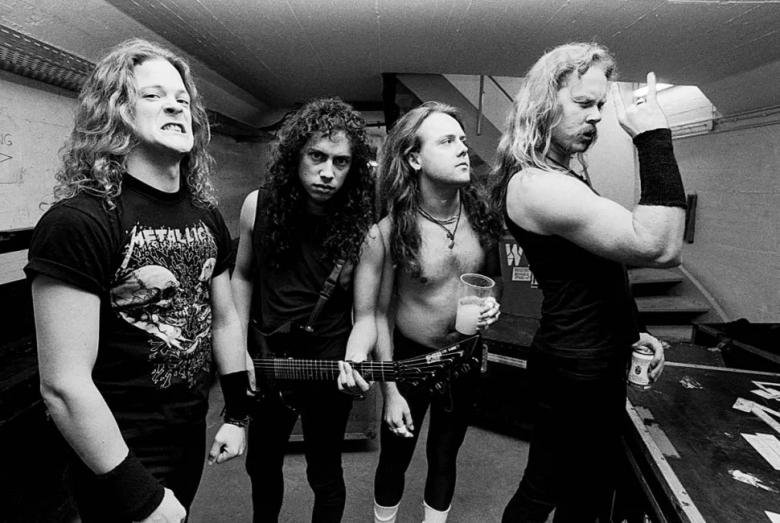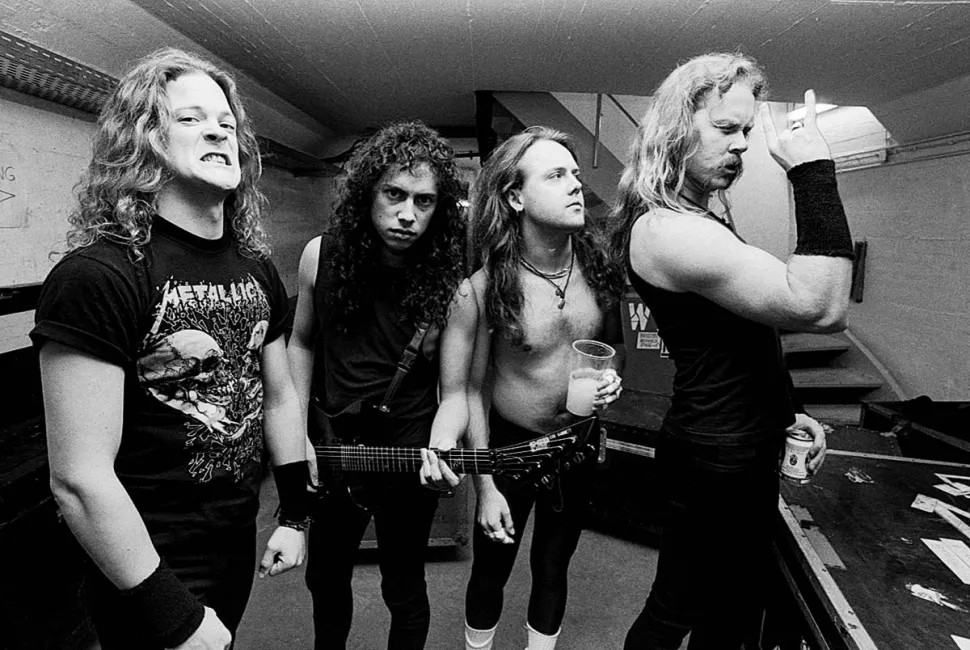
- Home
- Interviews
- METALLICA’S JAMES HETFIELD AND KIRK HAMMETT LOOK BACK ON 30 YEARS OF THE BLACK ALBUM: "IT REALLY WAS THE MASTER KEY TO EVERYTHING"
METALLICA’S JAMES HETFIELD AND KIRK HAMMETT LOOK BACK ON 30 YEARS OF THE BLACK ALBUM: "IT REALLY WAS THE MASTER KEY TO EVERYTHING"
By the end of the 1980s, heavy metal – and, in particular, thrash metal – had become something of a musical arms race. “It was all about impressing the other bands with your heaviness, with your speed, with your technical prowess,” Metallica frontman James Hetfield recalls to Guitar World. “Everyone wanted to come up with the heaviest riff on earth or the fastest song possible.”
Given that Metallica had already spent most of the decade gleefully pushing the boundaries of heaviness, speed and technicality on each of their first four recordings – 1983’s Kill ’Em All, the following year’s Ride the Lightning, 1986’s Master of Puppets and 1988’s …And Justice for All – they decided that, for their fifth release, they’d try something a little different. “The next album,” guitarist Kirk Hammett says, “was going to be shorter, simpler songs.”
That album, officially released August 12, 1991, as Metallica, but better known as The Black Album, was, true to Hammett’s words, characterized by more concise and straightforward compositions, in particular when compared to its exceedingly proggy predecessor, …And Justice for All. But it was also much, much more.
Working with a new producer, Bob Rock, who had recently helmed Mötley Crüe’s mainstream smash, 1989’s Dr. Feelgood, the band – which, in addition to Hetfield and Hammett included drummer Lars Ulrich and now ex-bassist Jason Newsted – crafted something that not only became the biggest heavy metal album of its day, but one that, at more than 35 million copies sold worldwide, is quite likely the most successful heavy metal album ever.
Metallica topped the charts in 10 countries, including the U.S., and managed the seemingly conflicting feats of redefining the very sound of heavy metal (sure, the music was still heavy, speedy and technically proficient, but it was also hookier, groovier and, sometimes, even – gasp! – softer) while also rocketing Metallica up and out of the genre’s somewhat stifling sonic confines.
Post-Black Album, Metallica were not just the biggest metal band going; they were an undeniable, unstoppable, unabashed global rock phenomenon. The album’s hit singles – and there were a lot of ’em (like, Michael Jackson and Madonna levels of ’em) – need no introduction. Enter Sandman. Sad But True. Nothing Else Matters. The Unforgiven. Wherever I May Roam.
If you’ve listened to rock or metal radio over the past 30 years, spent any time growing up watching something called MTV or woodshedding the tabs in various issues of this very magazine, you likely know them by heart.
But you’ll know them – along with The Black Album’s additional seven tracks – in a whole new way after listening to the new Metallica 30th anniversary reissue. Befitting a record as monumental as The Black Album, the amount of music on offer on the new release is, in a word, staggering.
Metallica is available in various formats, including remastered standard CD and 3CD expanded editions, double vinyl LP, cassette and digital.
But the motherload is the fully maxed-out Deluxe Box Set, comprised of 14 CDs packed with riffs, rehearsals, rough mixes, demos, interviews and live shows, six DVDs featuring outtakes, behind-the-scenes moments, official videos, home movies and even more live shows, a double vinyl LP of the newly remastered original album, a Sad But True picture disc and three live LPs (not to mention a plethora of additional goodies, including a 120-page hardcover book, four tour laminates, three lithos, three guitar picks, a Metallica lanyard, a folder with lyric sheets and a download card).
The result is that, in addition to hearing the album’s 12 tracks in sonically pristine form, fans also can experience the songs at every stage of creation, from initial riffs to works in progress, rehearsal run-throughs to studio demos, unreleased alternate takes to live versions captured on stages in Los Angeles and London, New Mexico and Moscow.
“It definitely pulls back the curtain,” Hammett says simply. What’s more, the reissue is accompanied by a second release, The Metallica Blacklist, featuring 53 artists from every corner of the music world – rock, pop, metal, country, indie, punk, hip-hop, jazz, electronic and more – tackling their favorite Black Album songs.
So you get Metallica peers and acolytes like Ghost, Volbeat and Slipknot’s Corey Taylor paying their respects on renditions of Enter Sandman, Don’t Tread on Me and Holier Than Thou, respectively, but also Miley Cyrus (Nothing Else Matters), Kamasi Washington (My Friend of Misery), Jason Isbell (Sad But True), the HU (Through the Never), José Madero (The Unforgiven) and J. Balvin (Wherever I May Roam) showing their own unique Metallica love and demonstrating that, even today, the band’s reach knows no stylistic or geographical bounds.
t’s a celebration of epic proportions, and one suitable for an album whose influence and enduring appeal is similarly unmatched. With that in mind, Guitar World took the rare opportunity to sit down with Hetfield and Hammett for an exclusive in-depth chat about the making of the legendary album, as well as that inimitable moment in time.
“It was one of those things where the situation and the circumstances and just everything around you seemed to be exactly where it should be,” Hammett says. “We had so much momentum behind us, we were willing to work, we were hungry as fuck and we knew that these songs were great. We were a young band and we felt pretty unstoppable.”
At the same time, he continues, “No one knew this was something they wanted until they heard it. But once they did, they were just like, ‘Oh, this is exactly what we want…’ ”
As it turned out, it was also exactly what Metallica needed. “It gave us carte blanche to be whatever we wanted to be, and to go wherever we wanted to go,” Hetfield says about the record. “So we’re very aware of what The Black Album was, what it did and the doors it opened for us. And now we’re showing our respect for it.”
It’s been 30 years since the release of The Black Album. 30 years since Enter Sandman and Sad But True and Nothing Else Matters. 30 years since, essentially, Metallica became the biggest metal band, if not the biggest rock band, on the planet. Does it feel like it was that long ago?
JAMES HETFIELD: [Laughs] “Well, because we’ve played these songs live so much, when we’re up there onstage it doesn’t seem like that long ago. But as far as talking about it or remembering things about it? It seems like a lifetime ago, for sure. I mean, we’ve gone through so many things as a band that most things seem really stretched out at this point. But the fact that the album is still relevant keeps it very present in my mind.”
KIRK HAMMETT: “When I think about it historically, 30 years sounds like a long time. But you know, I’m reminded of The Black Album on a regular basis. And I think that goes for the four of us. It’s something that just kind of prevails.
“You hear it on the radio and see it mentioned in the media, or I’ll be sitting on the beach and a car will go by and it’s cranking Sad But True. The album never really went away. It’s like, our last record, [2016’s Hardwired… to Self-Destruct], the cycle’s come and gone. But somehow The Black Album is still here!”
The thing that’s great about the new Metallica Deluxe Box Set – and you did a similar thing with the …And Justice for All and Master of Puppets anniversary releases – is that it really showcases “the process.”
You can listen to say, Enter Sandman or The Unforgiven in its earliest “Riff Tape” form, and then follow the song’s progression via a “Writing in Progress” version, a pre-production rehearsal and various alternate takes, before winding up at the officially released studio version.
It shines a light on the craftsmanship involved, and how, often, it’s through a series of seemingly minuscule tweaks that you arrive at something truly great.
HETFIELD: “Sure. It’s little things like, ‘Maybe let’s go a half-step up or down over here.’ Or you add in some minor stuff over there, which was always pretty easy and natural for us to do. But with The Black Album maybe we were doing a little less of the minor thing and going a little more toward major-key changes, or toward more simple stuff.
“And that was a challenge for us. But we were able, with Bob Rock’s help and each other’s help, to push ourselves into something that had a little more muscle, a little more depth, a little more thickness.”
HAMMETT: “And it demonstrates that we’re not a band that just shows up, someone has a cool riff, and then at the end of the day the song is complete. It’s never, ever like that for us. Even right now, we’re working on an album – or, at least, we’re getting songs together – and it’s the same process.
“Not one month ago, we were recording drum tracks and, literally, like three minutes before we recorded the drums, we were tweaking the song and changing the arrangement. We’ll say, ‘Maybe after that riff it should be a chromatic part instead of a whole-step thing.’ Or, ‘Maybe we play that riff two times instead of four times.’ Or, ‘Let’s play it three-and-a-half times.’ And we’ll look at each other and go, ‘How is it going to work to play it three-and-a-half times?’
“But then we work it out and we play it three-and-a-half times, you know? So that process has been with us for a long time. And those tweaks are important because that’s how we put our personality into the music. The more we tweak it, the more it sounds like Metallica.
Kirk, you wrote the main Enter Sandman riff, and your early versions of it, which differ a bit from what we ultimately hear on The Black Album version, are included in the box set. How did you first come up with that riff?
HAMMETT: “It was something that literally came to me at three o’clock in the morning. I had been listening to the new Soundgarden album at that time [Louder Than Love] and, you know, this was when grunge was at its earliest stage – we’re talking late 1989 or so. No one was even calling it grunge yet. But I was loving a lot of it, and it was influencing me somewhat.
“And so I sat down and I said to myself, as I always do, ‘I want to write the next Smoke on the Water.’ And I just started messing around. I got the swing kind of feel going, and then I was thinking of Soundgarden and how they were using dropped tunings.
“I wasn’t playing in a drop tuning, but with those tunings it’s often octave work – you get the low D, and then you go to the upper D and it sounds really heavy. I wasn’t in drop D, I was just in E, but I was messing around with the low and high octaves, and then I threw a tritone in there, an A#, went to the A, and that’s the riff that came out.
It’s not the type of riff you likely would have presented for, say, Master of Puppets or …And Justice for All.
HAMMETT: Well, now that I think about that riff more, I remember that when the first part of it came to me, I thought, ‘It sounds like it’s asking a question, and now I’ve got to resolve it.’ So that’s where the chunky chord part, with the G and F#, came in. And famously, when I originally wrote the riff [sings the riff in its original form], that chunky thing happened at the end of every line.
“Then Lars said, ‘Repeat the first part.’ So we changed it to where we repeat the first part three times and then the chunky chords come in. That made it hookier and bouncier – less heavy metal. It made a good-sounding riff fucking great.
“But if you think about the way the riff was originally – chunkier, more metal – you know, maybe it could have ended up on …And Justice for All.”

The oft-told story has always been that The Black Album’s tighter, more concise song arrangements and simpler riffs were a direct reaction to the extreme progressiveness of …And Justice for All. You wanted to pull back. D’you think this is accurate?
HETFIELD: “It is. Justice was kind of a dead end. And we needed to not so much pull back, but rather to push through that dead end. And maybe get back to something. Because for me, a lot of the songs that I enjoyed covering or writing on, like, Kill ’Em All, they were a lot shorter, a little more simplistic.
“And on Justice we had gone as far as we could with the complexity and with the showmanship. Then when we went out on tour and started playing those songs live, it was obvious that we lost the audience a little bit. We lost ourselves a little bit. We got a little caught up in the technicality of the playing and we couldn’t perform as much.
“When you’re up there onstage, I mean, the music moves you and you want to be able to move around. And some of those parts were too difficult to do that with, at least for me they were. And I’m not the kind of musician that wants to just stand there at a microphone. I want to express the music through my body as well. So we had to ask ourselves, ‘Where else can we go from here?’
HAMMETT: The song …And Justice for All, on that tour [Damaged Justice] we would play it at the end of the set and we used to joke about how long it was. You know, ‘It’s a good thing there’s some pyro at the end of it to wake everyone up!’ Because it’s so fucking progressive.
“There’s, like, 36 parts to it, and the arrangement snakes and weaves and goes all over the place. So we were very aware of what we were asking from our fans from a technical standpoint with that album. And the decision to go in a different direction stemmed from realizing that and deciding we weren’t going to do that again.”
HAMMETT: “There was a very, very conscious effort with The Black Album to not have the songs turn out like the ones on …And Justice for All. We wanted to get to the point quicker and sooner. It was an exercise in restraint, which was progress for us. And at the other end of it, we went full-in on the recording of it and the execution of it.
“It was probably the most extensive recording we ever did. And a lot of that was because we were working with Bob Rock for the first time, and we really wanted the album to sound above and beyond anything we’d ever done.”
It certainly sounds different than …And Justice for All. You can hear Jason’s bass, for starters.
HAMMETT: “We knew we had to get as far away from the sound of …And Justice For All as possible. Because we knew the sound of that record was…unique. [Laughs] And it wasn’t something we were really interested in sustaining. It was an experiment, you know?
“But people ask me all the time if we’re ever going to remaster that album with bass, and the answer to that is, adamantly, no. That’s like having Leonardo da Vinci paint glasses on the Mona Lisa or something. It’s just not something you do with art. That was then and this is now. You don’t add now to then.”
Read the complete interview here.

